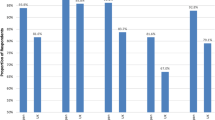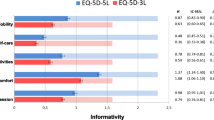Abstract
Purpose
This study examines the EQ-5D-5L pain/discomfort dimension by drawing comparisons with five other pain and discomfort items (pain severity, discomfort severity, pain frequency, discomfort frequency and pain interference) collected in the Australian psychometric study for the EQ Health and Wellbeing instrument.
Methods
Participants, recruited via a market research company, completed an online survey. Methods of analyses included the assessment of descriptive statistics, variation in reporting patterns using chi-square tests and cross-tabulations, correlation analyses, ordered univariate logistic regression, and discriminatory power analyses (Shannon index (H′) and Shannon Evenness index (J′)).
Results
Survey data from 514 participants were used. Compared with EQ-5D-5L pain/discomfort, there was a higher proportion of respondents reporting some level of impairment on at least one of the pain severity and discomfort severity items (74% versus 81%). Correlation with EQ-5D-5L pain/discomfort was strongest for pain severity (r = 0.83) and weakest for discomfort frequency (r = 0.41); the same inferences were drawn for predictive ability. Adding any additional pain or discomfort items to the EQ-5D-5L increased the absolute informativity (H′) but not the relative informativity (J′). When replacing EQ-5D-5L pain/discomfort with separate pain and/or discomfort items – i.e., adding items to a modified ‘EQ-4D-5L’—absolute informativity increased, while relative informativity increased only when pain interference and frequency-related items (independently or in combination) were added.
Conclusion
The EQ-5D-5L pain/discomfort dimension captures aspects of pain more than aspects of discomfort. Potential reasons include the absence of descriptors or because pain is mentioned first in the composite item.

Similar content being viewed by others
Data availability
Data cannot be shared publicly. However interested researchers are invited to contact the corresponding author to discuss data access options.
References
Trachsel, L. & Cascella, M. (2020). Pain theory. StatPearls Publishing, from https://www.ncbi.nlm.nih.gov/books/NBK545194/
Raja, S. N., Carr, D. B., Cohen, M., Finnerup, N. B., Flor, H., Gibson, S., Keefe, F. J., Mogil, J. S., Ringkamp, M., Sluka, K. A., Song, X. J., Stevens, B., Sullivan, M. D., Tutelman, P. R., Ushida, T., & Vader, K. (2020). The revised international association for the study of pain definition of pain: Concepts, challenges, and compromises. Pain, 161(9), 1976–1982. https://doi.org/10.1097/j.pain.0000000000001939
Younger, J., McCue, R., & Mackey, S. (2009). Pain outcomes: A brief review of instruments and techniques. Current Pain and Headache Reports, 13(1), 39–43. https://doi.org/10.1007/s11916-009-0009-x
Kennedy-Martin, M., Slaap, B., Herdman, M., van Reenen, M., Kennedy-Martin, T., Greiner, W., Busschbach, J., & Boye, K. S. (2020). Which multi-attribute utility instruments are recommended for use in cost-utility analysis? A review of national health technology assessment (HTA) guidelines. The European Journal of Health Economics, 21(8), 1245–1257. https://doi.org/10.1007/s10198-020-01195-8
Szende, A., Oppe, M., & Devlin, N., (2007) EQ-5D Value sets: Inventory, comparative review and user guide. EuroQol Group Monographs, (vol. 2). Springer
Herdman, M., Gudex, C., Lloyd, A., Janssen, M., Kind, P., Parkin, D., Bonsel, G., & Badia, X. (2011). Development and preliminary testing of the new five-level version of EQ-5D (EQ-5D-5L). Quality of Life Research, 20(10), 1727–1736. https://doi.org/10.1007/s11136-011-9903-x
Gudex, C. (2005). The descriptive system of the EuroQol instrument. In P. Kind, R. Brooks, & R. Rabin (Eds.), EQ-5D concepts and methods: A developmental history (pp. 19–27). Springer.
McDonald, R., Mullett, T. L., & Tsuchiya, A. (2020). Understanding the composite dimensions of the EQ-5D: An experimental approach. Social Science and Medicine, 265, 113323. https://doi.org/10.1016/j.socscimed.2020.113323
Rencz, F., & Janssen, M. F. (2022). Analyzing the pain/discomfort and anxiety/depression composite domains and the meaning of discomfort in the EQ-5D: A mixed-methods study. Value Health. https://doi.org/10.1016/j.jval.2022.06.012
Tsuchiya, A., Bansback, N., Hole, A. R., & Mulhern, B. (2019). Manipulating the 5 dimensions of the EuroQol instrument: The effects on self-reporting actual health and valuing hypothetical health states. Medical Decision Making, 39(4), 379–392. https://doi.org/10.1177/0272989X19851049
Whalley, D., Globe, G., Crawford, R., Doward, L., Tafesse, E., Brazier, J., & Price, D. (2018). Is the EQ-5D fit for purpose in asthma? Acceptability and content validity from the patient perspective. Health and Quality of Life Outcomes, 16(1), 160. https://doi.org/10.1186/s12955-018-0970-3
Yang, F., Jiang, S., He, X. N., Li, H. C., Wu, H. Y., Zhang, T. T., & Wu, J. (2020). Do rural residents in China understand EQ-5D-5L as intended? Evidence from a qualitative study. Pharmacoecon Open, 5(1), 101–109. https://doi.org/10.1007/s41669-020-00212-z
Fox-Rushby, J. (2005). First steps to assessing semantic equivalence of the EuroQol instrument: Results of a questionnaire survey to members of the EuroQol group. In P. Kind, R. Brooks, & R. Rabin (Eds.), EQ-5D concepts and methods: A developmental history (pp. 35–52). Springer.
Brazier, J., Peasgood, T., Mukuria, C., Marten, O., Kreimeier, S., Luo, N., Mulhern, B., Pickard, A. S., Augustovski, F., Greiner, W., Engel, L., Belizan, M., Yang, Z., Monteiro, A., Kuharic, M., Gibbons, L., Ludwig, K., Carlton, J., Connell, J., … Rejon-Parrilla, J. C. (2022). The EQ-HWB: Overview of the development of a measure of health and wellbeing and key results. Value Health, 25(4), 482–491. https://doi.org/10.1016/j.jval.2022.01.009
Carlton, J., Peasgood, T., Mukuria, C., Connell, J., Brazier, J., Ludwig, K., Marten, O., Kreimeier, S., Engel, L., Belizan, M., Yang, Z., Monteiro, A., Kuharic, M., Luo, N., Mulhern, B., Greiner, W., Pickard, S., & Augustovski, F. (2022). Generation, selection, and face validation of items for a new generic measure of quality of life: The EQ-HWB. Value Health, 25(4), 512–524. https://doi.org/10.1016/j.jval.2021.12.007
Peasgood, T., Mukuria, C., Brazier, J., Marten, O., Kreimeier, S., Luo, N., Mulhern, B., Greiner, W., Pickard, A. S., Augustovski, F., Engel, L., Gibbons, L., Yang, Z., Monteiro, A. L., Kuharic, M., Belizan, M., & Bjorner, J. (2022). Developing a new generic health and wellbeing measure: Psychometric survey results for the EQ-HWB. Value Health, 25(4), 525–533. https://doi.org/10.1016/j.jval.2021.11.1361
Stewart-Brown, S., Tennant, A., Tennant, R., Platt, S., Parkinson, J., & Weich, S. (2009). Internal construct validity of the Warwick-Edinburgh mental well-being scale (WEMWBS): A Rasch analysis using data from the Scottish health education population survey. Health and Quality of Life Outcomes, 7, 15. https://doi.org/10.1186/1477-7525-7-15
Netten, A., Burge, P., Malley, J., Potoglou, D., Towers, A. M., Brazier, J., Flynn, T., Forder, J., & Wall, B. (2012). Outcomes of social care for adults: Developing a preference-weighted measure. Health Technology Assessment, 16(16), 1–166. https://doi.org/10.3310/hta16160
Richardson, J., Sinha, K., Iezzi, A., & Khan, M. A. (2014). Modelling utility weights for the assessment of quality of life (AQoL)-8D. Quality of Life Research, 23(8), 2395–2404. https://doi.org/10.1007/s11136-014-0686-8
Akoglu, H. (2018). User’s guide to correlation coefficients. Turk J Emerg Med, 18(3), 91–93. https://doi.org/10.1016/j.tjem.2018.08.001
Janssen, B., Birnie, E., & Bonsel, G. J. (2007). Evaluating the discriminatory power of EQ-5D, HUI2 and HUI3 in a US general population survey using Shannon’s indices. Quality of Life Research, 16(5), 895–904. https://doi.org/10.1007/s11136-006-9160-6
Spronk, I., Bonsel, G. J., Polinder, S., van Baar, M. E., Janssen, M. F., & Haagsma, J. A. (2021). The added value of extending the EQ-5D-5L with an itching item for the assessment of health-related quality of life of burn patients: An explorative study. Burns, 47(4), 873–879. https://doi.org/10.1016/j.burns.2020.08.015
Gamst-Klaussen, T., & Lamu, A. N. (2020). Does the EQ-5D usual activities dimension measure what it intends to measure? The relative importance of work, study, housework, family or leisure activities. Quality of Life Research, 29(9), 2553–2562. https://doi.org/10.1007/s11136-020-02501-w
Spronk, I., Bonsel, G. J., Polinder, S., van Baar, M. E., Janssen, M. F., & Haagsma, J. A. (2020). Exploring the relation between the EQ-5D-5L pain/discomfort and pain and itching in a sample of burn patients. Health and Quality of Life Outcomes, 18(1), 144. https://doi.org/10.1186/s12955-020-01394-0
van Dongen-Leunis, A., Redekop, W. K., & Uyl-de Groot, C. A. (2016). Which questionnaire should be used to measure quality-of-life utilities in patients with acute leukemia? An evaluation of the validity and interpretability of the EQ-5D-5L and preference-based questionnaires derived from the EORTC QLQ-C30. Value Health, 19(6), 834–843. https://doi.org/10.1016/j.jval.2016.05.008
Hoogendoorn, M., Oppe, M., Boland, M. R. S., Goossens, L. M. A., Stolk, E. A., & Rutten-van Molken, M. (2019). Exploring the impact of adding a respiratory dimension to the EQ-5D-5L. Medical Decision Making, 39(4), 393–404. https://doi.org/10.1177/0272989X19847983
Bhardwaj, P., & Yadav, R. (2015). Measuring pain in clinical trials: Pain scales, endpoints, and challenges. Int J Clin Exp Physiol, 2(3), 151–156. https://doi.org/10.4103/2348-8093.169965
Schneider, S., Junghaenel, D. U., Keefe, F. J., Schwartz, J. E., Stone, A. A., & Broderick, J. E. (2012). Individual differences in the day-to-day variability of pain, fatigue, and well-being in patients with rheumatic disease: Associations with psychological variables. Pain, 153(4), 813–822. https://doi.org/10.1016/j.pain.2012.01.001
Durham, J., Steele, J. G., Breckons, M., Story, W., & Vale, L. (2015). DEEP study: Does EQ-5D-5L measure the impacts of persistent oro-facial pain? Journal of Oral Rehabilitation, 42(9), 643–650. https://doi.org/10.1111/joor.12296
Khadka, J., Gothwal, V. K., McAlinden, C., Lamoureux, E. L., & Pesudovs, K. (2012). The importance of rating scales in measuring patient-reported outcomes. Health and Quality of Life Outcomes, 10, 80. https://doi.org/10.1186/1477-7525-10-80
Bryan, S., Jowett, S., Hardyman, W., and Bentham, P., 2004 Does the EQ-5D ‘"nxiety/depression" item measure anxiety, depression, both or neither?. In 21st Scientific Plenary Meeting of the EuroQol Group. Chicago, US
Acknowledgements
We thank Professor Aki Tsuchiya for her discussion of an earlier draft of our paper at the 37th virtual EuroQol Plenary in 2020.
Funding
This study was funded by the EuroQol Research Foundation. Views expressed in this paper are not necessarily those of the EuroQol Research Foundation.
Author information
Authors and Affiliations
Contributions
All authors contributed to the study conception and design. Material preparation and data collection were performed by LE and BM. Data analysis was performed by LE. The first draft of the manuscript was written by LE and all authors commented on previous versions of the manuscript. All authors read and approved the final manuscript.
Corresponding author
Ethics declarations
Competing interests
All authors are members of the EuroQol Group Association.
Ethical approval
Ethical approval for the study was granted by the University of Technology Sydney Human Research Ethics Committee (ref. ETH18-2507). All participants provided implied consent by completing the online survey.
Additional information
Publisher's Note
Springer Nature remains neutral with regard to jurisdictional claims in published maps and institutional affiliations.
Rights and permissions
Springer Nature or its licensor (e.g. a society or other partner) holds exclusive rights to this article under a publishing agreement with the author(s) or other rightsholder(s); author self-archiving of the accepted manuscript version of this article is solely governed by the terms of such publishing agreement and applicable law.
About this article
Cite this article
Engel, L., Whitehurst, D.G.T., Haagsma, J. et al. What is measured by the composite, single-item pain/discomfort dimension of the EQ-5D-5L? An exploratory analysis. Qual Life Res 32, 1175–1186 (2023). https://doi.org/10.1007/s11136-022-03312-x
Accepted:
Published:
Issue Date:
DOI: https://doi.org/10.1007/s11136-022-03312-x




